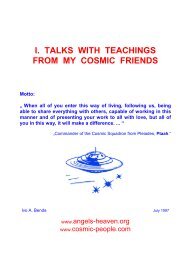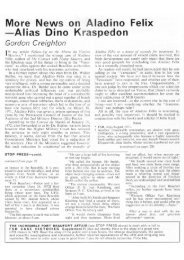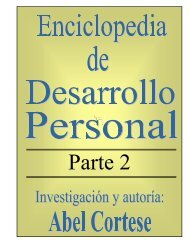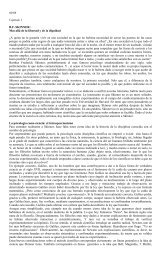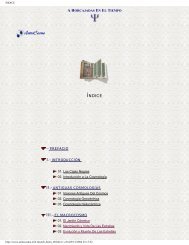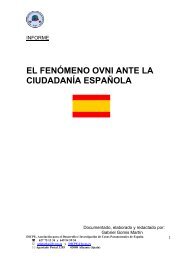The Word That is God
The Word That is God
The Word That is God
Create successful ePaper yourself
Turn your PDF publications into a flip-book with our unique Google optimized e-Paper software.
thoughts emanating from the subconscious, are themselves the forces of karma. So to wipe<br />
out our karma we must wipe out the samskaras through meditation on Om.<br />
All viable spiritual paths (practices) lead to Om. So it <strong>is</strong> only w<strong>is</strong>dom to become involved<br />
with It from the very beginning.<br />
Narada Parivrajaka Upan<strong>is</strong>had<br />
“He shall receive instructions on the Pranava. …[At the end of h<strong>is</strong> life] he shall d<strong>is</strong>card h<strong>is</strong><br />
body remembering [reciting] the emancipating holy mantra, Om.<br />
“He should ever be intent upon the realization, through meditation, of the Brahma Pranava<br />
[the Pranava that <strong>is</strong> Brahman].” (Narada Parivrajaka Upan<strong>is</strong>had, Upadesha VII)<br />
To realize Om through continuous japa and meditation <strong>is</strong> to realize Brahman Itself.<br />
“It <strong>is</strong> necessary for all to mediate upon the Self [Atman]. Thus the aspirant after liberation<br />
should ever be uttering the Pranava which enables one to cross samsara, and be living as a<br />
jivanmukta.” (Narada Parivrajaka Upan<strong>is</strong>had, Upadesha VII)<br />
“Narada asked Parameshthi [the Exalted One: Brahma] to enlighten him about the samsara<br />
taraka–that Pranava which lifts one out of samsara. Assenting to th<strong>is</strong>, Brahma began thus:<br />
‘Omkara that <strong>is</strong> Brahman <strong>is</strong> the vyashti [individual] and the samashti [cosmic]. What <strong>is</strong> the<br />
individual? What <strong>is</strong> the cosmic? <strong>The</strong> Brahma Pranava <strong>is</strong> of three kinds: Samhara [destructive]<br />
Pranava, Shr<strong>is</strong>hti [creative] Pranava, and Ubhayatmaka [belonging to both] Pranava, as being<br />
of two forms, internal and external.’” (Narada Parivrajaka Upan<strong>is</strong>had, Upadesha VIII)<br />
It <strong>is</strong> Om that delivers us from the sea of rebirth and confers liberation upon us. Although<br />
one, and of a single, unified consciousness, yet, being Brahman, It <strong>is</strong> also many; and some of<br />
Its aspects are being presented here.<br />
Om <strong>is</strong> samhara–that which cuts off and d<strong>is</strong>solves–in relation to all impurity and ignorance.<br />
At the same time it <strong>is</strong> the power of creation, of manifestation, in relation to all that <strong>is</strong> true and<br />
divine in nature. It <strong>is</strong> therefore ubhayatmaka–simultaneously destructive and creative. Th<strong>is</strong><br />
also <strong>is</strong> the nature of Brahman, the producer of both manifestation and d<strong>is</strong>solution. Pranava<br />
cuts off and d<strong>is</strong>solves that which <strong>is</strong> unreal and brings about the r<strong>is</strong>e and establ<strong>is</strong>hment of <strong>That</strong><br />
Which <strong>is</strong> Real. And It does so on the level of the microcosm, the vyashti, and on the level of<br />
the macrocosm, the samashti. All states of ex<strong>is</strong>tence are embraced by It, both the part and the<br />
Whole. It <strong>is</strong> the life of the individual spirit and of the Supreme Spirit equally. And it <strong>is</strong> <strong>That</strong><br />
which unites the two into One.<br />
“It <strong>is</strong> also eight: Antah Pranava, Vyavaharika Pranava, Bahya Pranava, Arsha Pranava,<br />
Ubhayatmaka or Virat Pranava, Samahara Pranava, Brahma Pranava, and Ardhamatra Pranava.”<br />
(Narada Parivrajaka Upan<strong>is</strong>had, Upadesha VIII)<br />
It <strong>is</strong> the Antah Pranava, the internal or indwelling Pranava, for it <strong>is</strong> the nature of<br />
consciousness–our own nature. It <strong>is</strong> the inmost, the most subtle, productive of all internal<br />
states and movements. Yet It <strong>is</strong> also the Vyavaharika Pranava, the power that manifests in all<br />
cosmic activity, producing all phenomenon. Thus It <strong>is</strong> also the Bahya Pranava, the external<br />
Pranava. It <strong>is</strong> the primal, holy mantra revealed to the Vedic R<strong>is</strong>h<strong>is</strong>, the Arsha Pranava. It <strong>is</strong> the<br />
all-containing (Ubhayatmaka) or cosmic (Virat) Pranava. But it also d<strong>is</strong>solves the cosmos as<br />
38



